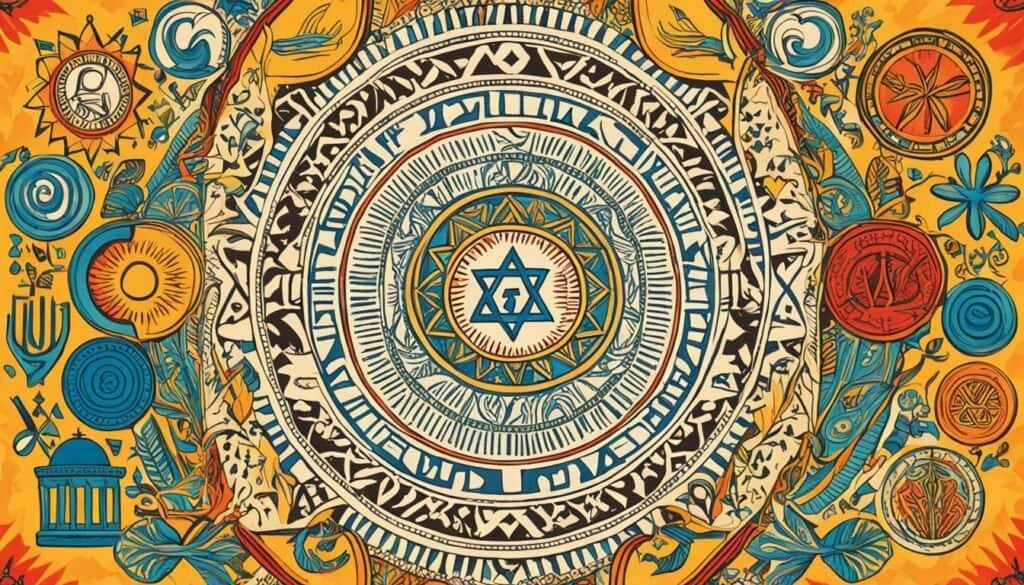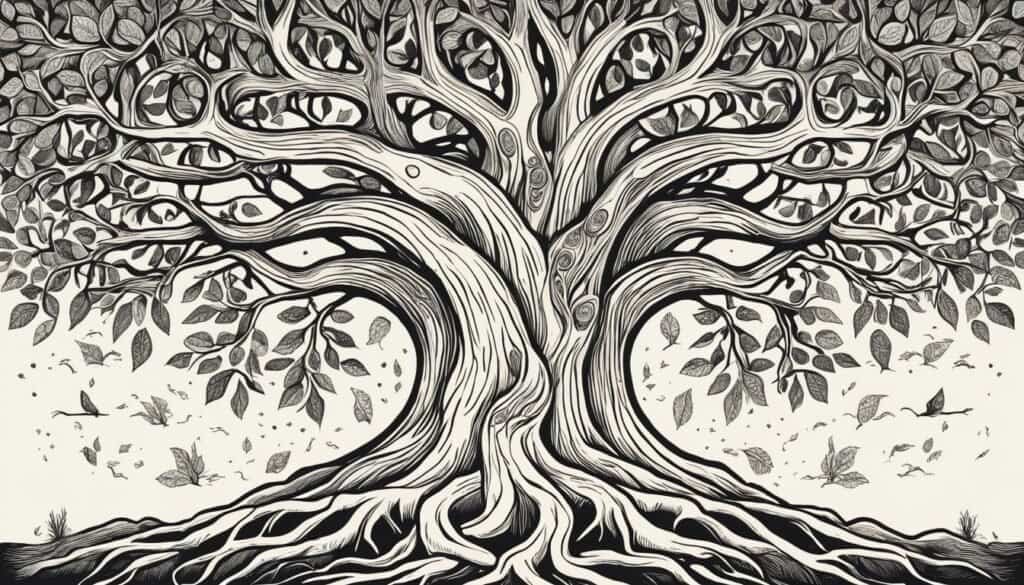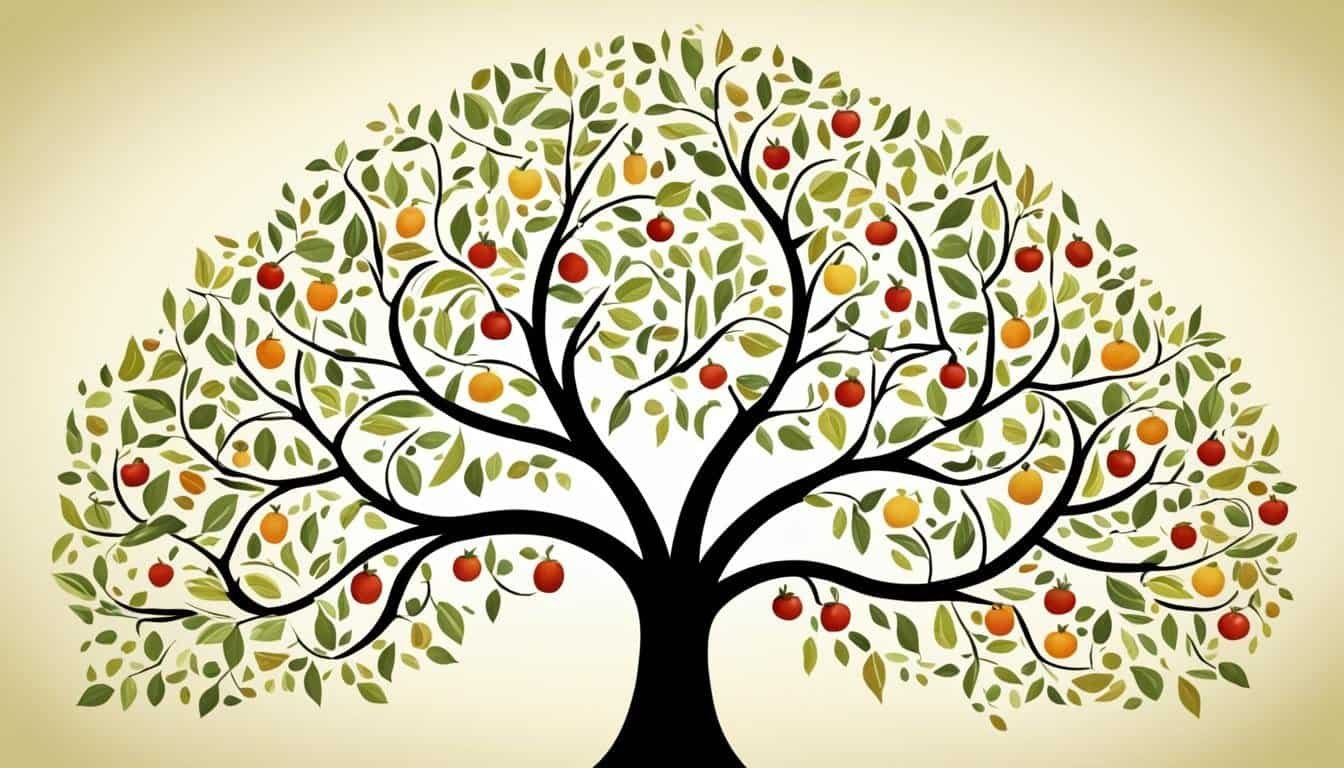In the book of Genesis, we find a treasure trove of genealogies that trace the roots of biblical ancestry. These lineages connect key figures from Adam to the tribes of Israel, providing us with a profound insight into the connections and relationships that shaped the course of biblical history.
But why are these genealogies so important?
What can we learn from the family trees of our ancient ancestors?
Do they merely serve as a historical record, or do they hold a deeper significance in our understanding of our own spiritual heritage?
In this article, we will embark on a journey through the genealogies traced in the book of Genesis. We will explore the line of descent from Adam to Noah, discover the nations descended from Noah’s sons, dive into the family line from Shem to Abram, and unravel the intricate connections of Isaac’s sons and Esau’s descendants, among others.
Join us as we delve into the depths of biblical ancestry, unlocking the mysteries and revelations hidden within these ancient genealogies.
Key Takeaways:
- Genesis is rich with genealogies that provide insights into biblical ancestry.
- These genealogies connect key figures from Adam to the tribes of Israel.
- Understanding these lineages deepens our knowledge of biblical history and heritage.
- Genealogies offer a glimpse into the rich tapestry of nations and peoples mentioned in the Bible.
- Exploring these genealogies helps us appreciate the intricate connections between biblical figures and events.
The Genealogy from Adam to Noah (Genesis 5)
In the book of Genesis, Chapter 5 provides a remarkable genealogy that traces the line of descent from Adam, the first man, to Noah, who played a pivotal role in the biblical narrative. This genealogy presents us with a detailed record of the ages of the patriarchs and offers valuable insights into the early generations of humanity.
The genealogy begins with the creation of Adam, the father of all mankind, and follows through the lineage of his son Seth. Each patriarch is accompanied by the number of years they lived, as well as the age at which they had their successor. This meticulous chronology provides us with a historical framework and allows us to understand the passage of time between these significant figures.
“And all the days of Seth were nine hundred and twelve years: and he died.” – Genesis 5:8
As we journey through this genealogy, we encounter notable figures such as Enoch, who famously “walked with God” and was taken away before his natural death, and Methuselah, known for being the oldest person mentioned in the Bible, having lived for 969 years.
The ages of the patriarchs not only serve as a testament to their longevity but also symbolize the gradual decline of human life expectancy following the fall of humanity. These ages provide us with a fascinating perspective on the early chapters of human history as described in the biblical text.
Exploring the genealogy from Adam to Noah in Genesis 5 allows us to appreciate the intricate connections and the passage of time between these key figures. It deepens our understanding of biblical ancestry and sheds light on the lives of those who played significant roles in shaping the course of human civilization.
| Patriarch | Age at Son’s Birth | Total Lifespan |
|---|---|---|
| Adam | 130 | 930 |
| Seth | 105 | 912 |
| Enosh | 90 | 905 |
| Kenan | 70 | 910 |
| Mahalalel | 65 | 895 |
| Jared | 162 | 962 |
| Enoch | 65 | 365 (translated) |
| Methuselah | 187 | 969 |
| Lamech | 182 | 777 |
| Noah | 500 | 950 |
This genealogy from Adam to Noah in Genesis 5 provides us with a remarkable glimpse into the line of descent, the ages of the patriarchs, and the early generations of humanity according to the biblical narrative.
The Sons of Noah (Genesis 10)
In the book of Genesis, we find a fascinating genealogy that traces the nations descended from Noah’s three sons – Shem, Ham, and Japheth – after the great flood. This genealogy, documented in Genesis 10, provides us with a glimpse into the diverse origins of various nations and peoples, as mentioned in the Bible.
After the cataclysmic flood, Noah and his family were chosen by God to repopulate the Earth. Noah’s sons, Shem, Ham, and Japheth, played a pivotal role in this restoration process. The genealogy in Genesis 10 outlines the lineages of these three brothers, revealing the nations that descended from them.
| Son of Noah | Nations Descended |
|---|---|
| Shem | Assyria, Elam, Aram, Lud, Arpachshad, Uz, Hul, Gether, Meshech, Tiras |
| Ham | Cush, Egypt, Put, Canaan |
| Japheth | Gomer, Magog, Madai, Javan, Tubal, Meshech, Tiras, Elishah, Tarshish, Kittim, Dodanim |
The table above provides a concise overview of the nations descended from each of Noah’s sons, highlighting the rich diversity of cultures and peoples that emerged after the flood. These nations played significant roles in the biblical narrative and the course of human history.
It is important to note that while the genealogy in Genesis 10 offers a valuable historical framework, it does not provide an exhaustive list of all nations and peoples that existed during that time. Rather, it focuses on those nations that had significant interactions with the Israelites and played prominent roles in the biblical storyline.

The image above depicts the Sons of Noah, serving as a visual representation of the diverse nations descended from this biblical family. It highlights the significant impact they had on shaping human civilization after the catastrophic flood.
Exploring the genealogy in Genesis 10 allows us to appreciate the rich tapestry of humanity’s origins. It reminds us of the multitude of cultures and peoples that have populated the Earth throughout history, all tracing their roots back to the sons of Noah. By understanding this lineage, we gain a deeper understanding of our shared heritage and the interconnectedness of human civilization.
The Line of Shem to Abram (Genesis 11:10-26)
In Genesis 11:10-26, we delve into the genealogy that traces the line of Shem to Abram, who later becomes known as Abraham. This lineage is of utmost importance as it establishes the ancestral connection to one of the most significant figures in biblical history.
Shem, the son of Noah, plays a critical role in this genealogy. As we navigate through the generations, we uncover the names of his descendants, including Arphaxad, Salah, Eber, Peleg, Reu, Serug, Nahor, and Terah.
Terah, the father of Abram, marks a turning point in this genealogical journey. He is the patriarch who sets the stage for the remarkable story that unfolds in the following chapters of Genesis.
This lineage serves not only as a historical record but also reveals the divine plan unfolding through successive generations. Each name carries significance, and the careful tracing of this genealogy paints a vivid picture of God’s chosen people and the unfolding of His covenant.
“And Abram took Sarai his wife, and Lot his brother’s son, and all their possessions that they had gathered, and the people that they had acquired in Haran, and they set out to go to the land of Canaan. When they came to the land of Canaan, Abram passed through the land to the place at Shechem, to the oak of Moreh. At that time the Canaanites were in the land.”
As we read this passage in Genesis, we witness the beginning of Abram’s journey, which will lead to the establishment of the nation of Israel and the fulfillment of God’s promises.
Historical Significance
The lineage from Shem to Abram not only showcases the direct connection between these biblical figures but also highlights their pivotal role in the unfolding plan of salvation and redemption.
Through Abram, God would establish a covenant that would shape the destiny of His chosen people. The story of Abram’s descendants, traced back to Shem, serves as a foundation for the biblical narrative and provides crucial context for understanding the broader historical and spiritual significance of events to come.
Ishmael’s Descendants (Genesis 25:12-18)
In Genesis 25:12-18, we find an intriguing genealogy that traces the lineage of Ishmael, Abraham’s son with Hagar. This genealogy sheds light on Ishmael’s descendants, revealing the formation of twelve distinct tribes and the broader family tree of Abraham.
“And these are the generations of Ishmael, Abraham’s son, whom Hagar the Egyptian, Sarah’s servant, bore to Abraham. These are the names of the sons of Ishmael, named in the order of their birth: Nebaioth, Kedar, Adbeel, Mibsam, Mishma, Dumah, Massa, Hadad, Tema, Jetur, Naphish, and Kedemah. These are the sons of Ishmael and these are their names, by their villages and by their encampments, twelve princes according to their tribes.”
The genealogy in Genesis 25:12-18 gives us valuable insights into the descendants of Ishmael. The twelve sons mentioned in this genealogy went on to establish twelve tribes, each with their own village and encampment, forming a significant part of Ishmael’s legacy.
Exploring this genealogy helps us understand the broader family connections within Abraham’s lineage. It allows us to trace the paths of Ishmael’s descendants, their settlements, and the intricate tapestry of their tribal identities within biblical history.
As we continue to delve into the genealogies traced in the book of Genesis, the lineage of Ishmael offers us a unique perspective on the diversification and expansion of Abraham’s descendants. Let us now move forward to explore the genealogy of Isaac’s sons and Esau’s descendants.
Isaac’s Sons and Esau’s Descendants (Genesis 36)
In Genesis 36, we delve into the intricate family line of Isaac’s two sons, Jacob and Esau. This genealogy provides us with valuable insights into the connections between these prominent biblical figures and the subsequent generations that emerged from their lineage.
Esau, being the elder of the two brothers, bore several descendants who went on to play significant roles in history. Among these were his wives, sons, and daughters, each contributing to the growth and expansion of their respective tribes.
Highlighting the Edomite tribal chiefs, Genesis 36 gives us an understanding of the leadership structure within the Edomite community. These tribal chiefs held crucial positions of authority and responsibility, guiding their people through various challenges and triumphs.
The Edomite Tribal Chiefs
“These are the chiefs of the sons of Esau, the Edomites, according to their families and their dwelling places, by their names: chief Timna, chief Alvah, chief Jetheth…” (Genesis 36:40-41)
As we explore the family line of Jacob and Esau, it becomes apparent that their descendants played pivotal roles in shaping the biblical narrative. From Esau’s marriages to the subsequent generations of Edomite tribal chiefs, a wealth of historical and cultural significance is unveiled, showcasing the complexity and depth of the biblical narrative.
Through genealogical accounts such as Genesis 36, we gain a fuller appreciation for the intricate interconnectedness of biblical figures, their family lines, and the subsequent impact they had on the broader narrative of faith and history.
The Twelve Tribes of Israel (Genesis 35:22-26)
Genesis 35:22-26 introduces us to the twelve sons of Jacob, who later became the patriarchs of the tribes of Israel. This genealogy holds immense significance as it unravels the origins of the nation of Israel and offers valuable insights into the history and lineage of each tribe.
The sons of Jacob, also known as the twelve tribes of Israel, played a crucial role in shaping the destiny of the Hebrew people. Each tribe carried the name of one of Jacob’s sons and became the foundation of a distinct community within the nation. These tribes took on diverse responsibilities, such as military defense, spiritual leadership, and the preservation of traditional customs and practices.
The twelve tribes consisted of:
- Reuben (meaning “behold, a son”)
- Simeon (meaning “one who hears”)
- Levi (meaning “attached” or “joined”)
- Judah (meaning “praise”)
- Dan (meaning “judge”)
- Naphtali (meaning “my struggle”)
- Gad (meaning “troop” or “fortune”)
- Asher (meaning “happy” or “blessed”)
- Issachar (meaning “reward” or “compensation”)
- Zebulun (meaning “to dwell”)
- Joseph (meaning “may he add”)
- Benjamin (meaning “son of the right hand”)
These tribes formed the backbone of the emerging nation of Israel, with each tribe inheriting a specific territory once they settled in the Promised Land. The descendants of the twelve tribes played integral roles throughout biblical history, and their stories and legacies continue to inspire and shape religious beliefs and cultural practices.

Their journey, filled with triumphs and challenges, echoes through the biblical narrative and offers essential lessons about leadership, community, and faith. By understanding the genealogy of the twelve tribes of Israel, we gain a deeper appreciation for the intricate tapestry of Israel’s history and the enduring influence of the sons of Jacob, the patriarchs of these tribes.
The Line of David (Genesis 38)
Genesis 38 tells the captivating story of Judah and Tamar, which plays a pivotal role in the genealogical line leading to King David. This narrative sheds light on the significance of King David in the biblical context and the fulfillment of Messianic prophecies associated with his lineage.
The sequel follows Judah’s encounter with Tamar, his daughter-in-law, after the tragic deaths of his first two sons. In a moment of deception, Tamar disguises herself as a prostitute and seduces Judah, resulting in her pregnancy. When Tamar’s pregnancy is discovered, Judah acknowledges his role in the situation and exclaims, “She is more righteous than I” (Genesis 38:26).
This unexpected turn of events eventually leads to the birth of twins, Perez and Zerah. Perez, one of the twins, becomes an important ancestor in the lineage leading to King David. The genealogy from Judah to David establishes a vital connection in the biblical narrative, highlighting the faithfulness of God’s promises and the significance of David as an anointed king.
“The scepter shall not depart from Judah, nor a lawgiver from between his feet, until Shiloh comes; and to Him shall be the obedience of the people.” – Genesis 49:10
King David, also known as the “man after God’s own heart,” plays a central role throughout the biblical accounts. His reign symbolizes the fulfillment of divine promises and marks a crucial era in the history of Israel. David’s lineage eventually leads to the birth of Jesus Christ, who is often referred to as the “Son of David” in the New Testament.

| Name | Relation to King David |
|---|---|
| Judah | Direct ancestor of King David |
| Perez | Son of Judah, an ancestor in the line leading to King David |
| Hezron | Son of Perez and an ancestor in the line leading to King David |
| Ram | Son of Hezron and an ancestor in the line leading to King David |
| Amminadab | Son of Ram and an ancestor in the line leading to King David |
| Nahshon | Son of Amminadab and an ancestor in the line leading to King David |
| Salmah | Son of Nahshon and an ancestor in the line leading to King David |
| Boaz | Son of Salmah and an ancestor in the line leading to King David |
| Obed | Son of Boaz and an ancestor in the line leading to King David |
| Jesse | Son of Obed and the father of King David |
The Seven Generations from Noah to Abram (Genesis 11:10-32)
In the book of Genesis, we find a genealogical record that spans from the sons of Noah to Abram, who would later be known as Abraham. This genealogy, found in Genesis 11:10-32, is an essential link between the pre-flood and post-flood eras, providing us with valuable insights into the transition from one era to the next in biblical history.
The genealogy begins with Shem, one of Noah’s sons who survived the catastrophic flood. From Shem, we trace the line of descent through seven generations, spanning a significant period of time. Each generation adds new layers of history and significance to the biblical narrative.
As we explore these seven generations, we gain a deeper understanding of the social, cultural, and spiritual dynamics at play during this transitional period. We witness the advancements and challenges experienced by humanity as they navigated life in the post-flood era.
This genealogy serves as a bridge, connecting the pre-flood world to the story of Abram and his descendants, who would go on to shape the history of Israel and impact the course of human civilization.
By studying this genealogy, we can uncover valuable insights into the foundations of biblical history and the divine plan unfolding through generations. It deepens our understanding of the intricate connections between key figures and events, allowing us to appreciate the significance of each link in the chain of ancestry.
The Seven Generations from Noah to Abram
| Generation | Name | Years Lived |
|---|---|---|
| 1 | Shem | 600 |
| 2 | Arphaxad | 438 |
| 3 | Shelah | 433 |
| 4 | Eber | 464 |
| 5 | Peleg | 239 |
| 6 | Reu | 239 |
| 7 | Serug | 230 |
| 8 | Nahor | 148 |
| 9 | Terah | 205 |
| 10 | Abram (Abraham) | 175 |
This table provides an overview of the seven generations from Noah to Abram, including the names and years lived by each individual. It showcases the passage of time and the gradual progression of generations, leading to the pivotal figure of Abram.
By studying the genealogy and exploring these seven generations, we can grasp the rich tapestry of biblical history and the profound impact of individuals who played crucial roles in shaping the course of human civilization.

How Do the Symbolic Meanings in Genesis Connect to the Genealogies Traced in the Book?
The symbolic meanings in Genesis are deeply connected to the genealogies traced in the book. Each individual mentioned in the genealogies carries a symbolic significance that contributes to the overall narrative of creation, sin, redemption, and the establishment of God’s chosen people.
Nahor’s Descendants (Genesis 22:20-24) and Keturah’s Descendants (Genesis 25:1-4)
In Genesis 22:20-24, we discover the lineage of Nahor, Abraham’s brother. This genealogy lists the 12 sons born to Nahor and provides valuable insight into the extended family lines of Abraham. Understanding Nahor’s descendants helps us piece together a more comprehensive picture of the biblical narrative and the relationships within Abraham’s family.
In Genesis 25:1-4, we encounter another important genealogy, this time pertaining to the sons born to Abraham through his wife Keturah. These sons were born after Sarah’s death, and their inclusion in the biblical narrative expands our understanding of the family lines connected to Abraham. These genealogical records deepen our appreciation for the vast network of relatives and descendants surrounding Abraham in his life.
By exploring both Nahor’s descendants and Keturah’s descendants, we gain a more holistic understanding of the family lines connected to Abraham. These genealogies not only offer valuable historical information but also contribute to the biblical narrative’s overarching storyline. Understanding the intricate connections between family members provides a richer context for interpreting and engaging with the biblical text.
Affiliate Disclosure: "As an Amazon Associate I earn from qualifying purchases made from links in this post. We are a participant in the Amazon Services LLC Associates Program, an affiliate advertising program designed to provide a means for us to earn fees by linking to Amazon.com."

